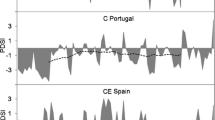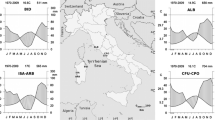Abstract
The growth response of Mongolian pine (Pinus sylvestris var. mongolica) to climate was studied at three sites in the Hulun Buir steppe on the eastern Mongolian Plateau, China. Correlation analysis revealed two patterns of response: (1) trees on two sites in the upstream section of the Yimin River are strongly limited by temperature and precipitation during the growing season from April to September, and (2) trees in the convergence area of the downstream section of the Yimin River and of the midstream section of the Hailar River are sensitive to precipitation during winter (December–January) and early spring (April) as well as to the early growing season temperature (April and June). These responses can be attributed to the positions where groundwater, recharged by the runoff from summer to autumn (July–September), could supply sufficient water needed for tree growth. Therefore, the patterns of growth–climate responses and of climate variation trends in this steppe region should be considered for the management and afforestation of Mongolian pines.







Similar content being viewed by others
References
Bao G, Liu Y, Linderholm HW (2012) April–September mean maximum temperature inferred from Hailar pine (Pinus sylvestris var. mongolica) tree rings in the Hulunbuir region, Inner Mongolia, back to 1868 ad. Palaeogeography, Palaeoclimatology, Palaeoecology 313–314:162–172
Barber VA, Juday GP, Finney BP (2000) Reduced growth of Alaskan white spruce in the twentieth century from temperature-induced drought stress. Nature 405:68–673
Bogino SM, Jobbágy EG (2011) Climate and groundwater effects on the establishment, growth and death of Prosopis caldenia trees in the Pampas (Argentina). Forest Ecology and Management 262:1766–1774
Bräuning A (2001) Combined view of various tree ring parameters from different habitats in Tibet for the reconstruction of seasonal aspects of Asian Monsoon variability. The Palaeobotanist 50:1–12
Briffa KR, Schweingruber FH, Jones PD, Osborn TJ, Shiyatov SG, Vaganov EA (1998) Reduced sensitivity of recent tree-growth to temperature at high northern latitudes. Nature 391:678–682
Cao SX (2008) Why large-scale afforestation efforts in China have failed to solve the desertification problem. Environment Science and Technology 42:828–831
Chavardes RD, Daniels LD, Waeber PO, Innes JL, Nitschke CR (2013) Unstable climate − growth relations for white spruce in southwest Yukon, Canada. Climatic Change 116:593–611
Chen ZJ, Zhang XL, Cui MX, He XY, Ding WH, Peng JJ (2012) Tree-ring based precipitation reconstruction for the forest-steppe ecotone in northern Inner Mongolia, China and its linkages to the Pacific Ocean variability. Global and Planetary Change 86–87:45–56
Chinese Academy of Sciences (Compilatory Commission of Physical Geography of China) (1984) Physical Geography of China: Climate. Science Press, Beijing, pp 1–161 (in Chinese)
Cook ER, Meko DM, Stahle DW, Cleaveland MK (1999) Drought reconstructions for the continental United States. Journal of Climate 12:1145–1162
Creber GT, Chaloner WG (1984) Influence of environmental factors on the wood structure of living and fossil trees. The Botanic Review 50:357–448
Crimmins SM, Dobrowski SZ, Greenberg JA, Abatzoglou JT, Mynsberge AR (2011) Changes in climatic water balance drive downhill shifts in plant species’ optimum elevations. Science 331:324–327
Davi NK, Jacoby GC, D’Arrigo RD, Baatarbileg N, Li JB, Curtis AE (2008) A treering-based drought index reconstruction for far-western Mongolia 1565–2004. Int J Climatol. doi:10.1002/joc.1798
Davi N, Jacoby G, Fang K, Li J, D’Arrigo R, Baatarbileg N, Robinson D (2010) Reconstructing drought variability for Mongolia based on a large-scale tree ring network:1520–1993. Journal of Geophysical Research 115:D22103. doi:10.1029/2010JD013907
Fang K, Gou X, Chen F, D’Arrigo R, Li J (2010) Tree-ring based drought reconstruction for the Guiqing Mountain (China): linkages to the Indian and Pacific Oceans. Int J Climatol 30:1137–1145
Fang KY, Gou XH, Chen FH, Liu CZ, Davi N, Li JB, Zhao ZQ, Li YJ (2012) Tree-ring based reconstruction of drought variability (1615–2009) in the Kongtong Mountain area, northern China. Global Planetary Change 80–81:190–197
Fritts HC (1976) Tree rings and climate. Academic Press, London
Gou XH, Chen FH, Yang MX, Jacoby G, Fang KY, Tian QH, Zhang Y (2008) Asymmetric variability between maximum and minimum temperatures in Northeastern Tibetan Plateau: evidence from tree rings. Sci China Ser D: Earth Sci 51(1):41–55
Gu TM (1991) Climate in North China plain. China Meteorological Press, Beijing, p 333 (in Chinese)
James TM (2011) Temperature sensitivity and recruitment dynamics of Siberian larch (Larix sibirica) and Siberian spruce (Picea obovata) in northern Mongolia’s boreal forest. Forest Ecology and Management 262:629–636
Jiao SR (1989) Structure and function of Mongolian pine plantation for sand fixation in Zhanggutai. Science and Technology Press of Liaoning Province, Shenyang, pp 1–36, in Chinese
Jiao SR (2001) Report on the causes of the early decline of Pinus sylvestris var. mongolica shelterbelt and its preventative and control measures in Zhanggutai of Liaoning Province. Scientia Silvae Sinicae 37:131–138 (in Chinese with English abstract)
Li SG (1994) A preliminary study on adaptation of Mongolian Scots pine to sandy land at Naiman, Inner Mongolia. J Desert Res 14:60–67 (in Chinese with English abstract)
Liang EY, Shao XM, Liu HY, Eckstein D (2007) Tree-ring based PDSI reconstruction since ad 1842 in the Ortindag Sand Land, east Inner Mongolia. Chinese Science Bulletin 52(19):2715–2721
Liang EY, Shao XM, Xu Y (2009) Tree-ring evidence of recent abnormal warming on the southeast Tibetan Plateau. Theoretical and Applied Climatology 98:9–18
Lindner M, Maroschek M, Netherer S, Kremer A, Barbati A, Garcia-Gonzalo J, Seidl R, Delzon S, Cornona P, Kolström M, Lexer J, Marchetti M (2010) Climate change impacts, adaptive capacity, and vulnerability of European forest ecosystems. Forest Ecology and Management 259:698–709
Liu Y, Sun JY, Cai QF, Song HM, Shi JF, An ZS, Li XX (2007) Tree-ring-derived precipitation records from Inner Mongolia, China, since a.d.1627. Tree-Ring Research 63(1):3–14
Liu Y, Bao G, Song HM, Cai QF, Sun JY (2009a) Precipitation reconstruction from Hailar pine (Pinus sylvestris var. mongolica) tree rings in the Hailar region, Inner Mongolia, China back to 1865 ad. Palaeogeogr, Palaeoclimatol, Palaeoecol 282:81–87
Liu Y, Linderholm HW, Song HM, Cai QF, Tian QH, Sun JY, Chen DL, Simelton E, Seftigen K, Tian H, Wang RY, Bao G, An ZS (2009b) Temperature variations recorded in Pinus tabulaeformis tree rings from the southern and northern slopes of the central Qinling Mountains, central China. Boreas 38(2):285–291
Liu H, Park Williams A, Allen CD, Guo D, Wu X, Anenkhonov OA, Liang E, Sandanov DV, Yin Y, Qi Z, Badmaeva NK (2013) Rapid warming accelerates tree growth decline in semi-arid forests of Inner Asia. Global Change Biology. doi:10.1111/gcb.12217
Pederson N, Jacoby GC, D’Arrigo R, Cook ER, Buckley BM, Dugarjav C, Mijiddorj R (2001) Hydrometeorological reconstructions for northeastern Mongolia derived from tree rings: ad 1651–1995. Journal of Climate 14:872–881
Pederson N, Cook EC, Jacoby G, Peteet DM, Griffin KL (2004) The influence of winter temperatures on the annual radial growth of six northern range margin tree species. Dendrochronologia 22:7–29
Peterson DW, Peterson DL (2001) Mountain hemlock growth responds to climatic variability at annual and decadal time scales. Ecology 82:3330–3345
Saxe H, Cannell MGR, Johnsen B, Ryan MG, Vourlitis G (2001) Tree and forest functioning in response to global warming. New Phytologist 149:369–399
Seo JW, Eckstein D, Jalkanen R, Rickebusch S, Schmitt U (2008) Estimating the onset of cambial activity in Scots pine in northern Finland by means of the heat-sum approach. Tree Physiology 28:105–112
Shen JG (2008) Meteorological disasters dictionary of China. Meteorological Press, Beijing, Inner Mongolia (in Chinese)
Tardif JC, Conciatori F, Nantel P, Gagnon D (2006) Radial growth and climate responses of white oak (Quercus alba) and northern red oak (Quercus rubra) at the northern distribution limit of white oak in Quebec, Canada. Journal of Biogeography 33:1657–1669
Tessier L, Guibal F, Schweingruber FH (1997) Research strategies in dendroecology and dendroclimatology in mountain environments. Climatic Change 36:499–517
Tuo Y (2001) Utilization and adjustment of water resources in Hailar. Inner Mongolia Water Resources 3:50–51 (in Chinese)
Vaganov EA, Hughes MK, Kirdyanov AV, Schweingruber FH, Silkin PP (1999) Influence of snowfall and melt timing on tree growth in subarctic Eurasia. Nature 400:149–151
Wang WH (1990) Climate of Inner Mongolia. China Meteorological Press, Beijing, pp 1–273 (in Chinese)
Wang HJ, He SP (2013) The increase of snowfall in Northeast China after the mid 1980s. Chinese Science Bulletin 12:1350–1354
Wang WH, Zhu T (2011) Analysis of hydrological characteristics for Hulunbeier grassland area. Water Resources and Hydropower of Northeast China 7:41–43 (in Chinese with English abstract)
Wang T, Hamann A, Yanchuck A, O’Neill GA, Aitken SN (2006) Use of response functions in selecting lodgepole pine populations for future climates. Global Change Biology 12:2404–2416
Wang XM, Zhang CX, Hasi E, Dong ZB (2010) Has the Three Norths Forest Shelterbelt Program solved the desertification and dust storm problems in arid and semiarid China? Journal of Arid Environments 74:13–22
Wei YF, Fang J, Zhao XY, Yi M, Zhang RJ, Li SG (2012) Isotopic model estimate of relative contribution of potential water pools to water uptake of Pinus sylvestris var. mongolica in Horqin Sandy Land. Journal of Resources and Ecology 3(4):308–315
Wigley TML, Briffa KR, Jones PD (1984) On the average value of correlated time series, with applications in dendroclimatology and hydrometeorology. Journal of Climate and Applied Meteorology 23:201–213
Wilmking M, Juday GP, Barber VA, Zald HSJ (2004) Recent climate warming forces contrasting growth responses of white spruce at treeline in Alaska through temperature thresholds. Global Change Biology 10:1724–1736
Yi L, Yu H, Ge J, Lai Z, Xu X, Qin L, Peng S (2011) Reconstructions of annual summer precipitation and temperature in north-central China since 1470 ad based on drought/flood index and tree-ring records. Climatic Change. doi:10.1007/s10584-011-0052-6
Yonenobu H, Eckstein D (2006) Reconstruction of early spring temperature for central Japan from the tree-ring widths of Hinoki cypress and its verification by other proxy records. Geophysical Research Letters 33:L10701. doi:10.1029/2006GL026170
Zhang JZ, Song LR (2010) Water resources development and countermeasures in the Hailar River Basin. Water Resources and Hydropower of Northeast China 12:4–35 (in Chinese)
Zhang WT, Jiang Y, Dong MY, Kang MY, Yang HC (2012) Relationship between the radial growth of Picea meyeri and climate along elevations of the Luyashan Mountain in North-Central China. Forest Ecology and Management 265:142–149
Zheng X, Zhu JJ, Yan QL, Song LN (2012) Effects of land use changes on the groundwater table and the decline of Pinus sylvestris var. mongolica plantations in southern Horqin Sandy Land, Northeast China. Agricultural Water Management 109:94–106
Zhu JJ, Fan ZP, Zeng DH, Jiang FQ, Matsuzaki T (2003) Comparison of stand structure and growth between artificial and natural forests of Pinus sylvestris var. mongolica on sandy land. Journal of Forestry Research 14(2):103–111
Zhu JJ, Kang HZ, Tan H, Xu ML (2006) Effects of drought stresses induced by polyethylene glycol on germination of Pinus sylvestris var. mongolica seeds from natural and plantation forests on sandy land. Journal of Forest Research 11:319–328
Zhu JJ, Li FQ, Xu ML, Kang HZ, Wu XY (2008) The role of ectomycorrhizal fungi in alleviating pine decline in semiarid sandy soil of northern China: an experimental approach. Annals of Forest Science 65:3041–30412
Zhu HF, Fang XQ, Shao XM, Yin ZY (2009) Tree ring-based February–April temperature reconstruction for Changbai Mountain in Northeast China and its implication for East Asian winter monsoon. Climate of the Past 5:661–666
Acknowledgments
The author thanks Professor Yu Liu and Director Yuxiang Ge for supporting this research. We also thank field editor Dr. Lynda Chambers and three anonymous reviewers for comments that greatly improved the clarity of this manuscript. This work was supported by the National Natural Science Foundation of China (41301101, 41171170), the Chinese Academy of Sciences (KZCX2-YW-Q1-01, KZZD-EW-04), the One-hundred Talents Program of the Chinese Academy of Sciences, National Basic Research Program of China (2013CB955903), the State Key Laboratory of Loess and Quaternary Geology Foundation (SKLLQG1302), Geography of Shaanxi Province key discipline, and Baoji University of Arts and Sciences (ZK11063).
Author information
Authors and Affiliations
Corresponding author
Rights and permissions
About this article
Cite this article
Bao, G. Mongolian pines (Pinus sylvestris var. mongolica) in the Hulun Buir steppe, China, respond to climate in adjustment to the local water supply. Int J Biometeorol 59, 1–10 (2015). https://doi.org/10.1007/s00484-013-0767-3
Received:
Revised:
Accepted:
Published:
Issue Date:
DOI: https://doi.org/10.1007/s00484-013-0767-3




